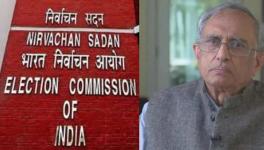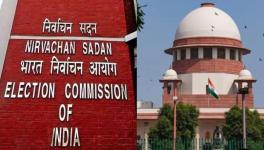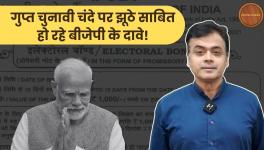Union Government will Continue with Conglomerate Capitalist’ Policies till Electoral Bonds Scheme is Struck Down
As concerns rise over whether the recently announced National Monetization Pipeline will serve to strengthen crony capitalism and private monopolies, VINEET BHALLA explains how this is part of the union government’s policy regimen for the last seven years. In order to facilitate voters’ fundamental right to information about electoral candidates, the Supreme Court must immediately strike down the electoral bond scheme, which has facilitated the clientelism between the ruling party and corporate tycoons through large anonymous donations.
THE National Monetization Pipeline, developed by NITI Ayog and launched earlier this month by the Union Finance Ministry, seeks to lease out assets belonging to various central ministries and public sector entities to private entities for an initial four-year period.
The NMP will supposedly “creat[e] employment opportunities, thereby enabling high economic growth and seamlessly integrating the rural and semi-urban areas for overall public welfare.”
Concerns about NMP
The programme has polarized experts and commentators. Apart from opposition parties, expert too have argued that it is yet another step by the current union government that fosters crony capitalism.
Columnist Andy Mukherjee has warned that “[w]ithout bureaucratic capability and regulatory acumen, the Indian program could become a transfer of taxpayer-funded assets to a handful of business groups. This is a concern because of the rising concentration of economic power in everything from transport to telecom.”
According to writer Sonali Ranade, “the scheme is tailor-made for rent seeking at all levels of the babudom and politicians. … Nobody will have the bandwidth to monitor how the scheme works at the operating level. Leakages will abound at all levels.” In which case, the cost of the same will be passed on by private operators to, who else, the common citizens.
Journalist Ranvir Nayar has also cautioned about poor returns and service, writing that “[t]here have been scores of examples in last one decade with the government auditor, the Comptroller and Accountant General, flagging how the private sector has shortchanged or even cheated the public sector partner or the government in such deals in the past.” He also cites examples from both India and the United Kingdom to demonstrate that since the private sector is always “keen on cutting costs and enhancing revenues, often at any price”, “there is a total lack of accountability towards consumers” who often have to bear the price.
Economist Dr S.K. Mohapatra has starkly written that “asset monetization may lead to the intensification of crony capitalism, create private monopolies, and trigger outright plunder of people’s wealth by cronies and will lead to disempowerment and impoverishment of masses.” He has forewarned that “[w]ithout bureaucratic capability and regulatory acumen, [NMP] could become a transfer of taxpayer-funded assets to a handful of business groups. This is a concern because of the rising concentration of economic power in everything from transport to telecom.”
‘Conglomerate capitalism’ and rising inequality
The last sentence brings us to the heart of the matter. For it is not my intention here to discuss the merits or demerits of the NMP (although several experts, such the ones cited above, have expressed scepticism about its likelihood of success, with Ranade predicting that the NMP wouldn’t result in any net addition “to gross savings in the economy, either by bringing in foreign savings, or by attracting a significant synergy premium”). It is to point out that that current Bharatiya Janta Party (BJP)-ruled union government has pursued economic policies that have ushered in, in the words of journalist Harish Damodaran, the ‘conglomerate’ phase of Indian capitalism, and the NMP is just the latest programme in pursuit of the same.
This phase is characterized by, as Damodaran describes it, “the accelerated movement towards industrial concentration and market dominance by large firms or conglomerates” across multiple sectors. This, he writes, “has been greatly facilitated by demonetization and GST that have eroded the competitive advantage smaller firms hitherto had from dealing in cash and not paying full taxes.”
Sample this: the ratio of profit of the 20 most profitable companies in India to the total profit generated by the Indian corporate sector has increased from about 40% in financial year 2014 to over 60% in financial year 2019.
Across most commercial sectors today, spanning infrastructure, fast moving consumer goods, commercial vehicles and many more, there are only two or three entities commanding more than 50% market share.
Some tycoons have especially benefited under the BJP regime. Gautam Adani, for instance, has increased his net worth by 230% to more than $260 billion ever since BJP came to power in 2014. His six listed enterprises added a combined $79 billion to their market value in 2020 in spite of the pandemic, capping the best 12 months in their history. He has been called ‘India’s infrastructure king’, with market leadership in mines, ports, power plants, airports, data centers and defense.
Mukesh Ambani, the richest man in India, whose company Reliance Industries is a market leader in petrochemicals, telecom and retail, along with Adani and Uday Kotak of Kotak Mahindra Bank, have all seen their wealth double since 2014. Overall, India added 40 billionaires in 2020 to total 177, all of whom increased their wealth by 35% during the pandemic, as per a report by the NGO Oxfam India.
It is likely that these billionaires will end up benefiting from the NMP.
Also read: After three decades of liberalisation, fruits of growth have not gone to poor
At the same time, as per the report, millions of people across India lost their jobs that year, primarily due to the stringent national lockdown. As per a survey cited in the report, 84% of all households suffered a loss in income in April 2020. Overall, over the financial year 2021, India’s GDP shrank by 7.3%.
A report by Azim Premji University indicates that the rural poverty rate increased by 15 percentage points and the urban poverty rate is up by 20 points due to the pandemic.
Analysis of pre-pandemic data indicates that under the BJP government, both the Gross Domestic Product (GDP) growth rate and the GDP per capita fell, while the unemployment rate rose. The Reserve Bank of India’s Annual Report for financial year 2021 termed the period between December 2016 and June 2020 as a “down-cycle” phase in India’s GDP cycle.
In 2019, the union government had granted a massive tax cut to corporate entities. The resultant shortfall has been made up by hiking up indirect taxes, which are disproportionate in nature, and hence hit the poor harder.
Also read: In post-Covid world, India must fix its broken tax structure to achieve social and economic justice
It is in this light that we must see protests across the country by farmers and public sector workers against government policies that they fear would benefit corporate tycoons and adversely affect their livelihoods.
It is almost as if the NMP is the latest product of a government policy that seems to be geared especially towards the wealth creation of the billionaires.
As written by me in a previous article, “while theoretically everyone has an equal say in the election process, it is materially true that competing in elections, and winning them, requires significant material resources. The 2019 Lok Sabha election is estimated to have “cost” political parties Rs.50,000 crores, or $7 billion, a full $0.5 billion higher than the cost of the 2016 US elections.”
It is almost as if these billionaires pay certain political parties to help win elections, and in return, the party in power helps the billionaires with favourable policies.
Unfortunately, there is no way to verify if that is the case or not, because of electoral bonds.
Electoral Bonds
In January 2018, the Electoral Bond scheme was notified by the union government. Prior to this, the Finance Act, 2017 had been passed by the Parliament which introduced electoral bonds into three legislation: the Representation of the People Act, 1951, the Income Tax Act, 1961, and the Reserve Bank of India Act, 1934.
Electoral bonds are financial instruments through which persons or corporations can make anonymous donations of the denominations of Rs 1,000, Rs 10,000, Rs 1 lakh, Rs 10 lakh, and Rs 1 crore to political parties. Parties, in turn, are exempt from reporting the source of donations received via electoral bonds to the Election Commission (EC). They can even get away with receiving donations from foreign sources through this route because of the legal opacity afforded to electoral bonds.
Since the launch of this scheme, it has become the most popular route of donations to political parties, with over half of the income of all parties coming from electoral bonds.
Also read: Electoral Bonds: SBI Sold Bonds Worth Rs 6,492.7 Crore during Past 3 Years without transparency
It has been reported that the BJP has received 68 % of all electoral bonds sold since the inception of the scheme, as a result of which it is by far the richest party in India (in financial year 2019, the BJP’s income was more than twice that of its five major rivals put together).
The scheme was challenged before the Supreme Court by the NGO Association for Democratic Reforms in 2017, and by the Communist Party of India (Marxist) in 2018. In an affidavit filed before the apex court in 2019, the EC stated that the scheme adversely affects transparency in the funding of political parties.
However, the Supreme Court has yet to decide on the challenge, and has twice refused to grant interim stay of the scheme.
Also read: Electoral Bonds: Supreme Court’s latest order another letdown
Voters’ fundamental right to information
It is obvious that the scheme violates the right to information about candidates contesting legislative assembly elections in the context of citizens’ right to vote. In 2003, a three-judge bench of the Supreme Court had held in its judgment in the case of Union of India vs. Association for Democratic Reforms that that the right to informed knowledge about public officials is derived from the fundamental right to freedom of expression under Article 19(1)(a).
As a result of this judgment, the disclosure of criminal antecedents, educational qualifications and assets of electoral candidates has been made mandatory under the Representation of the People Act.
Since it is established that citizens have the right to know such critical information about candidates, it follows that they must also know about who is funding the parties that are propping different candidates up.
Also read: Electoral Bonds: How compromised is our democracy
Last month, in a noted public lecture, Justice D.Y. Chandrachud had said:
“Truth is … important to instil a sense of public trust in democracies, that the officials in-charge are committed to finding the “truth” and acting in accordance with it. Hence, it is no surprise that the national motto of India after its independence has been “Satyamev Jayate” or “Truth Shall Prevail”.”
In order to bring to light the truth of the link between large corporate funding of political parties and corporate-friendly public policy, as well as fulfill the fundamental right to information of electors, it is essential that the Supreme Court expediently declare the electoral bond scheme as invalid, and bring out.
While that may not necessarily stop the BJP government from pursuing ‘conglomerate capitalism’, at least its reasons for doing so would become patently visible.
(Vineet Bhalla is a Delhi-based lawyer, and part of the editorial team at The Leaflet. The views expressed are personal.)
The article was originally published in The Leaflet.
Get the latest reports & analysis with people's perspective on Protests, movements & deep analytical videos, discussions of the current affairs in your Telegram app. Subscribe to NewsClick's Telegram channel & get Real-Time updates on stories, as they get published on our website.
























